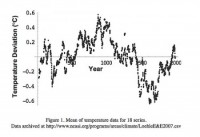
|
Nov 29, 2007
Global Warming is Not About to Unleash Hell on Us
By Nigel Lawson, former British Cabinet minister
As it is, the temperature projections (the Intergovernmental Panel on Climate Change) does come up with in its fourth and latest report range from a rise in the global average temperature by the year 2100 of 1.8C for its lowest emissions scenario to one of 4C for its highest emissions scenario, with a mean increase of slightly under 3C. The average annual temperature in Helsinki is less than 5C. That in Singapore is in excess of 27C, a difference of more than 22C. If man can cope with that, it is not immediately apparent why he should not be able to adapt to a change of 3C when he is given 100 years in which to do so. The major cause of ill-health, and the deaths it brings, in the developing world is poverty. Faster economic growth means less poverty but - according to the man-made CO2 warming theory, incorporated in the IPCC’s scenarios - a warmer world. Warmer but richer is in fact healthier than colder but poorer.
The more one examines the current global warming orthodoxy, the more it resembles a Da Vinci code of environmentalism. It is a great story and a phenomenal bestseller. It contains a grain of truth and a mountain of nonsense. And that nonsense could be very damaging indeed. We appear to have entered a new age of unreason, which threatens to be as economically harmful as it is profoundly disquieting. Read his excellent lecture here. Read media coverage here.
Nov 29, 2007
2007 Cools, Set to be 6th Warmest Year on Record
By Alister Doyle, Environment Correspondent, Reuters
This year is set to be the sixth warmest since records began 150 years ago, cooler than earlier predicted which means a slight respite for European ski resorts or bears trying to hibernate. “2007 will likely be near equal with 2006, so joint sixth warmest year,” Phil Jones, head of the Climatic Research Unit at Britain’s University of East Anglia, told Reuters.
The unit, which provides global data for the World Meteorological Organization (WMO), had predicted a year ago that 2007 could be the warmest worldwide since reliable records began in the 1860s. It cut the prediction to number 2 in mid-year.
Many of Europe’s Alpine ski resorts—starved of snow a year ago—have opened. In Switzerland 48 resorts, or more than half the total, opened about 10 days ago after good early snows and freezing temperatures. In northern Europe, resorts such as Hafjell have opened weeks before last year, when temperatures were too high even for snow-making machines.
And bears in a Bulgarian conservation park are starting to doze off for winter hibernations, around the normal time, after last year’s mild winter badly disrupted their sleep. “Four of the bears are sleeping already. The weather was a bit warm but last week it became colder and it snowed so they have fallen asleep,” said Raya Stoilova of the “Four Paws” foundation of 24 bears in a conservation park. For more go here. Note: The statement attributed to the IPCC “Eleven of the 12 years from 1995 to 2006 were among the 12 warmest years on record” is clearly not factual. For the US in the last century for example 6 of the 10 warmest were before 1960. There are major issues with the global data bases that make them unreliable for such an assessment.
Nov 27, 2007
The Trees Were Kidding: World Was Warmer Just a Few Centuries Ago
By Andrew Bolt, Herald Sun
The IPCC used it (the ‘hockey stick") in its third assessment report. Al Gore used it in his movie. In fact, no graphic has had such a huge effect as the infamous hockeystick produced by Michael Mann, who used tree ring data to allegedly show that the last century’s warming was unprecedented, and the globe had never in 2000 years been this hot.
Small problem. Mann’s manipulation of the statistics has since been discredited, and the graph dropped out of the IPCC’s fourth report. But the damage has been done. Millions of people now firmly believe the world hasn’t been this hot in recorded history, not even during the Medieval Warm Period. Now a new study says Mann didn’t just get the maths wrong, but could have been using tainted data as well. Ecological modeller Dr Craig Loehle has checked other proxy data, rather than the tree rings he says are unreliable, and comes up with a very different graphic indeed:

Says Loehle: “There are reasons to believe that tree ring data may not properly capture long-term climate changes. In this study, eighteen 2000-year-long series were obtained that were not based on tree ring data. Data in each series were smoothed with a 30-year running mean. All data were then converted to anomalies by subtracting the mean of each series from that series. The overall mean series was then computed by simple averaging. The mean time series shows quite coherent structure. The mean series shows the Medieval Warm Period (MWP) and Little Ice Age (LIA) quite clearly, with the MWP being approximately 0.3°C warmer than 20th century values at these eighteen sites.” To sum up. This warming is not unusual. The planet was warmer less than 1000 years ago. Oh, and see the fall in temperatures since 1998’s high, which so panicked so many people. Read more here.
Nov 26, 2007
The Phenomenological Approach to Estimating the Effect of Total Solar Irradiance on Climate
Post by Paul on Jennifer Marohasy Blog
The flawed ‘hockey stick’ temperature reconstruction is used to reduce the role of the sun in climate change. Little pre-industrial temperature variability would help support the claim that 20th century warming is mainly anthropogenic in origin. Scafetta and West have recently published a continuation of their phenomenological approach to estimating the role of total solar irradiance (TSI) in climate change, which compares TSI reconstructions with temperature reconstructions.

Interestingly, Scafetta and West conclude that: “if we assume that the latest temperature and TSI secular reconstructions, WANG2005 and MOBERG05, are accurate, we are forced to conclude that solar changes significantly alter climate, and that the climate system responds relatively slowly to such changes with a time constant between 6 and 12 years. This would suggest that the large-scale computer models of climate could be significantly improved by adding additional Sun-climate coupling mechanisms.” See this blog here. Read Scafetta and West’s paper here.
Nov 26, 2007
Concerning the Current Consensus on Climate Change
By Sherwood, Keith and Craig Idso, CO2 Science
In a Policy Forum article inspired by the most recent report of the Intergovernmental Panel on Climate Change (IPCC), Oppenheimer et al. (2007) write in the 14 September issue of Science that “with the general credibility of the science of climate change established, it is now equally important that policy-makers understand the more extreme possibilities that consensus may exclude or downplay.” Why is that? Because, as they continue, “setting aside or minimizing the importance of key structural uncertainties in underlying processes is a frequent outcome of the drive for consensus.”
In light of this illuminating admission, we note that the setting aside of key uncertainties in the climate modeling enterprise could well lead to more extreme possibilities at both ends of the climate prognostication spectrum, such that not only may earth’s surface air temperature rise somewhat more than is predicted by the current IPCC consensus, it could equally as easily rise somewhat less than that august group has opined. And for the IPCC’s current full range prediction of 21st century warming (1.1-6.4°C), somewhat less warming could well turn out to be indistinguishable from no warming at all.
But how could this possibly be? The answer may well be found in the implementation of another important principle enunciated by Oppenheimer et al., i.e., their contention that the basis for quantitative uncertainty estimates “must be broadened to give observational, paleoclimatic, or theoretical evidence of poorly understood phenomena comparable weight with evidence from numerical modeling.” Read more of this CO2 Science editorial here.
|
|
|
|




